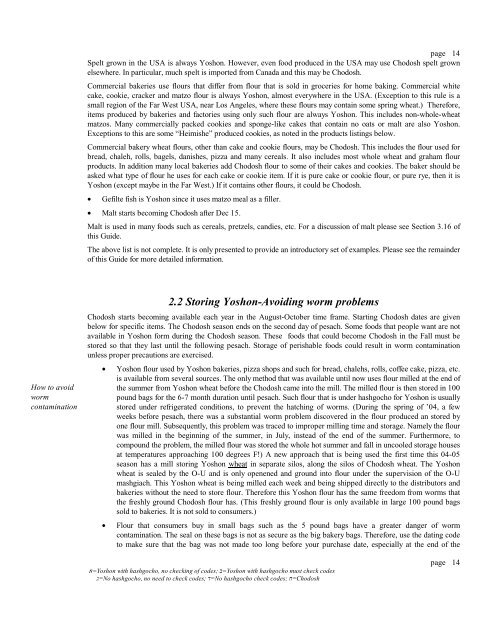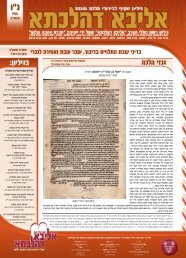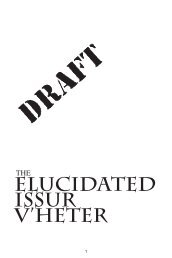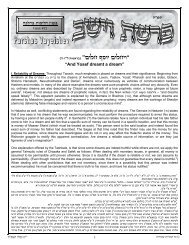You also want an ePaper? Increase the reach of your titles
YUMPU automatically turns print PDFs into web optimized ePapers that Google loves.
page 14Spelt grown in the USA is always Yoshon. However, even food produced in the USA may use Chodosh spelt grownelsewhere. In particular, much spelt is imported from Canada and this may be Chodosh.Commercial bakeries use flours that differ from flour that is sold in groceries for home baking. Commercial whitecake, cookie, cracker and matzo flour is always Yoshon, almost everywhere in the USA. (Exception <strong>to</strong> this rule is asmall region of the Far West USA, near Los Angeles, where these flours may contain some spring wheat.) Therefore,items produced by bakeries and fac<strong>to</strong>ries using only such flour are always Yoshon. This includes non-whole-wheatmatzos. Many commercially packed cookies and sponge-like cakes that contain no oats or malt are also Yoshon.Exceptions <strong>to</strong> this are some “Heimishe” produced cookies, as noted in the products listings below.Commercial bakery wheat flours, other than cake and cookie flours, may be Chodosh. This includes the flour used forbread, chaleh, rolls, bagels, danishes, pizza and many cereals. It also includes most whole wheat and graham flourproducts. In addition many local bakeries add Chodosh flour <strong>to</strong> some of their cakes and cookies. The baker should beasked what type of flour he uses for each cake or cookie item. If it is pure cake or cookie flour, or pure rye, then it isYoshon (except maybe in the Far West.) If it contains other flours, it could be Chodosh.• Gefilte fish is Yoshon since it uses matzo meal as a filler.• Malt starts becoming Chodosh after Dec 15.Malt is used in many foods such as cereals, pretzels, candies, etc. For a discussion of malt please see Section 3.16 ofthis Guide.The above list is not complete. It is only presented <strong>to</strong> provide an introduc<strong>to</strong>ry set of examples. Please see the remainderof this Guide for more detailed information.How <strong>to</strong> avoidwormcontamination2.2 S<strong>to</strong>ring Yoshon-Avoiding worm problemsChodosh starts becoming available each year in the August-Oc<strong>to</strong>ber time frame. Starting Chodosh dates are givenbelow for specific items. The Chodosh season ends on the second day of pesach. Some foods that people want are notavailable in Yoshon form during the Chodosh season. These foods that could become Chodosh in the Fall must bes<strong>to</strong>red so that they last until the following pesach. S<strong>to</strong>rage of perishable foods could result in worm contaminationunless proper precautions are exercised.• Yoshon flour used by Yoshon bakeries, pizza shops and such for bread, chalehs, rolls, coffee cake, pizza, etc.is available from several sources. The only method that was available until now uses flour milled at the end ofthe summer from Yoshon wheat before the Chodosh came in<strong>to</strong> the mill. The milled flour is then s<strong>to</strong>red in 100pound bags for the 6-7 month duration until pesach. Such flour that is under hashgocho for Yoshon is usuallys<strong>to</strong>red under refrigerated conditions, <strong>to</strong> prevent the hatching of worms. (During the spring of ’04, a fewweeks before pesach, there was a substantial worm problem discovered in the flour produced an s<strong>to</strong>red byone flour mill. Subsequently, this problem was traced <strong>to</strong> improper milling time and s<strong>to</strong>rage. Namely the flourwas milled in the beginning of the summer, in July, instead of the end of the summer. Furthermore, <strong>to</strong>compound the problem, the milled flour was s<strong>to</strong>red the whole hot summer and fall in uncooled s<strong>to</strong>rage housesat temperatures approaching 100 degrees F!) A new approach that is being used the first time this 04-05season has a mill s<strong>to</strong>ring Yoshon wheat in separate silos, along the silos of Chodosh wheat. The Yoshonwheat is sealed by the O-U and is only openened and ground in<strong>to</strong> flour under the supervision of the O-Umashgiach. This Yoshon wheat is being milled each week and being shipped directly <strong>to</strong> the distribu<strong>to</strong>rs andbakeries without the need <strong>to</strong> s<strong>to</strong>re flour. Therefore this Yoshon flour has the same freedom from worms thatthe freshly ground Chodosh flour has. (This freshly ground flour is only available in large 100 pound bagssold <strong>to</strong> bakeries. It is not sold <strong>to</strong> consumers.)• Flour that consumers buy in small bags such as the 5 pound bags have a greater danger of wormcontamination. The seal on these bags is not as secure as the big bakery bags. Therefore, use the dating code<strong>to</strong> make sure that the bag was not made <strong>to</strong>o long before your purchase date, especially at the end of theYoshon=ב with hashgocho must check codes codes; Yoshon=א with hashgocho, no checking ofChodosh=ח codes; No=ד hashgocho check codes; No=ג hashgocho, no need <strong>to</strong> checkpage14

















